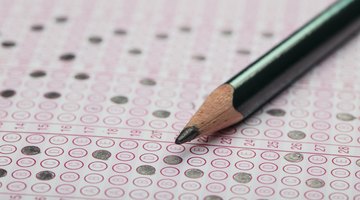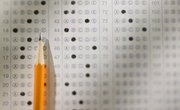Thinking about standardized testing brings anxiety to just about any high school student. The dreadful thought of facing bubble markings and time management during test taking suggests stressful times for many students. However, stressful test taking is not the only concern for most students in high school.
The SAT, or Scholastic Aptitude Test, is one of many types of standardized tests that high school students can take before graduating. Though the SAT is a common way for high school students to demonstrate competency for college readiness, the College Board received criticism about test questions and scoring. Among the criticisms of the SAT is whether the test widens the gap between races and genders in the student population.
Early SAT History
The SAT scores by race are not the only statistical measurement on which colleges relied to admit students into programs. In the late 19th century, colleges admitted students into programs based on social class rather than aptitude. By then, college professors from elite institutions saw the need to have a more accurate way to admit students. So, at the beginning of the 20th century, these professors developed a standardized test.
Amidst the turmoil of World War I in 1905, Carl Brigham started to develop IQ test for military recruits. Eventually, he began working on the Army intelligence projects that would grow into the SAT. While more than 2 million soldiers took the test during this time, Brigham continued with his research.
Hence, the analysis developed into an aptitude exam to evaluate learning processes more than how students acquired knowledge in school. Undeniably misusing the test, colleges used the test as a method to decline students from a program based on a correlation between race and scores.
Later SAT History
Decades later in the 1970s, the College Board revised the test questions and scoring several times. In 1994, the College Board modified questions to meet the content from college courses and even allowed calculators during testing. Another set of revisions came in 2005, changing the scoring and rewriting test items.
The latest revision to the SAT was in 2016. The College Board launched its new SAT format with modified test questions and scoring methodology. The new SAT aims to ensure that students have a chance to attend college despite gender, race and income.
SAT National Average Scores
With a new SAT format, score evaluation is different from the old SAT scoring. The College Board launched the new SAT in March 2016, and 1.7 million students took the test and 70 percent completed the SAT Essay section. The College Board reported that the SAT scores by race range among the three significant categories of white, Hispanic/Latino and African-American groups.
Of all the test takers, 44 percent were white, followed by 24 percent Hispanic/Latino and 13 percent African-American students. Furthermore, the SAT national average was 1060, with the Evidence-Based Reading and Writing section a mean score of 533 and the Math section a mean score of 527. However, the College Board insists that the mean scores indicate a baseline for colleges to evaluate student school performance. Students can still improve with practice and dedication.
With a new SAT, a new scoring determines a student’s college readiness based on specific benchmarks. The College Board emphasizes that the SAT national average is to evaluate student performance, not college readiness. That is, benchmark percentiles indicate college readiness. Nevertheless, test takers believe that a score is an indicator of college acceptance or denial.
Significance of SAT Scores by Race
Criticism revolves around the SAT scores by race from outside research besides the College Board, and the studies show discrepancies among their statistics.
- Initially, the College Board reported that white test takers had a mean score of 1118 with a benchmark of 59 percent.
- Hispanic/Latino test takers showed a mean score of 990 with a benchmark of 31 percent.
- African Americans had a mean score of 941 with a benchmark of 20 percent.
- Asian students showed a mean score of 1181 and met a benchmark of 70 percent.
- American Indian/Alaska natives had a mean score of 963 with a benchmark of 27 percent.
- Native Hawaiian/other Pacific islanders demonstrated a mean score of 986 and a benchmark of 32 percent.
- Those identifying as two or more races had a mean score of 1103 and a benchmark of 54 percent.
Regardless of race, gender or income, the benchmark scores evaluated the likelihood of student success in college. As a result, the benchmark percentages show a comparison among the same SAT scores by race and not in competition between races.
Other SAT Gender-Race Studies
Other studies indicated a disproportionate scoring among races. The Brookings study, based on math results from only the 2016 SAT scores, showed gaps among ethnic groups. They reported that African-American students showed scores between the 300 and 500 range, whereas white students showed scores between 300 and 800 points.
The study revealed several limitations. For instance, there is no comparison of scores from the Evidence-Based Reading and Writing section and the SAT national average scores for that year. Another comparison of SAT scores by race is the study by PrepScholar.
- The study, based on the 2018 scores, showed the SAT national average score of 1068, with an Evidence-Based Reading and Writing section score of 536 and a mean score for the Math section of 531.
- The study points out that white test takers scored an SAT national average of 1123, Hispanics scored 990 points and African Americans scored 946 points. The study includes gender-specific scoring.
For example, female students scored a national average of 1061 points, with a mean score of 522 for the Math section and a mean score of 539 for the Evidence-Based Reading and Writing section. On the other hand, male students showed a total score of 1076, with a mean score of 542 on the Math section and a mean score of 534 on the Evidence-Based Reading and Writing section. However, the study lacks findings of benchmark statistics for college readiness.
More SAT Statistics
Meanwhile, the SAT statistics show that the new SAT is an improvement from previous test versions, and student practice and a study plan support those high scores. Along with the partnership between school districts and Khan Academy, the College Board helped bring the SAT to many schools. The Official SAT Practice with Khan Academy increased students’ points by 200 or more. Another remarkable SAT statistic is the number of students using the programs.
More than 400,000 students use the free and individualized study plan, and the College Board expects the number to increase to 650,000 users by 2018. The study plan with Khan Academy helped students increase scores with more than 20 hours in the program. That is, the College Board indicates that by bringing the SAT School Day to many school districts across the country, there is a higher chance of students enrolling in college.
The Official SAT Practice All In Challenge
The SAT statistics suggest how these programs impact enrollment in college regardless of gender, race or income. The College Board works extensively with the Council of the Great City Schools to promote the Official SAT Practice All In Challenge, in which more than 168,000 students participated. Nothing impacts more than the SAT School Day in more than 250 school districts across the nation.
During this day, students take the SAT at no cost during regular school hours. This day prevents students from missing extracurricular activities, coming in outside of a school day or not helping with family activities. A future in college is real for many students regardless of race, gender or income.
Related Articles
References
Writer Bio
Barbara earned a B. S. in Biochemistry and Chemistry from the Univ. of Houston and the Univ. of Central Florida, respectively. Besides working as a chemist for the pharmaceutical and water industry, she pursued her degree in secondary science teaching. Barbara now writes and researches educational content for blogs and higher-ed sites.











